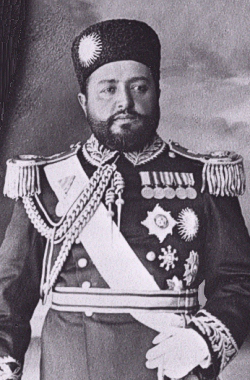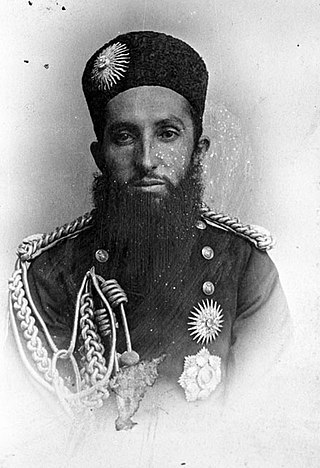
Abdur Rahman Khan GCSI was Emir of Afghanistan from 1880 to his death in 1901. He is known for uniting the country after years of internal fighting and negotiation of the Durand Line Agreement with British India.

European influence in Afghanistan has been present in the country since the Victorian era, when the competing imperial powers of Britain and Russia contested for control over Afghanistan as part of the Great Game.

Pashtunistan is a historical region in Central Asia and South Asia, inhabited by the indigenous Pashtun people of Afghanistan and western Pakistan. Wherein Pashtun culture, the Pashto language, and Pashtun identity have been based. Alternative names historically used for the region include Pashtūnkhwā (پښتونخوا), Pakhtūnistān, or Pathānistān. Predominantly located on the Iranian Plateau, Pashtunistan borders the geographical regions of Turkestan to the north, Kashmir to the northeast, Punjab to the east, and Balochistan to the south.

The Durand Line, forms the Pakistan–Afghanistan border, a 2,670-kilometre (1,660 mi) international land border between Pakistan and Afghanistan in South Asia. The western end runs to the border with Iran and the eastern end to the border with China.
Related to 1896 in Afghanistan: Negotiations are going on between the Indian government and the amir tending to the appointment of a joint commission for determining the last 100 miles (160 km) of Indo-Afghan frontier yet unsettled, from Landi Kotal in the Khyber to Nawar Kotal on the Kunar River.
The Mohmand or Mohmand is a prominent tribe of Pashtun people. They are based primarily in the Mohmand territory, which is located in Nangarhar, Afghanistan and Mohmand Agency, Pakistan.

The Second Anglo-Afghan War was a military conflict fought between the British Raj and the Emirate of Afghanistan from 1878 to 1880, when the latter was ruled by Sher Ali Khan of the Barakzai dynasty, the son of former Emir Dost Mohammad Khan. The war was part of the Great Game between the British and Russian empires.

Habibullah Khan was the Emir of Afghanistan from 1901 until his death in 1919. He was the eldest son of the Emir Abdur Rahman Khan, whom he succeeded by right of primogeniture in October 1901. His grandfather was Mohammad Afzal Khan.

Sir Henry Mortimer Durand, was a British Anglo-Indian diplomat and member of the Indian Civil Service.

Parachinar is a small Pashtun town which is the capital of Kurram District in the province of Khyber Pakhtunkhwa, Pakistan.

Nasrullah Khan, (1874–1920), sometimes spelt as Nasr Ullah Khan, was shahzada of Afghanistan and second son of Emir Abdur Rahman Khan. He held the throne of Afghanistan as Emir for one week, from 21 to 28 February 1919.
Nawab Khan Bahadur Sahibzada Sir Abdul Qayyum Khan KCIE, hailing from Topi, Swabi District, British India was an educationist and politician. Qayyum Khan helped Mortimer Durand during his negotiation of the Durand Line agreement with Afghanistan in 1893. Qayyum Khan became the first Chief Minister of the North-West Frontier Province on 1 April 1937. He is also known for establishing the Islamia College, Peshawar on the mould of Sir Syed Ahmad Khan's policy of educating Muslims.
The following lists events that happened during 1897 in Afghanistan.
The following lists events that happened during 1913 in Afghanistan.

Sayyid Abdul Latif or Sahibzada Abdul Latif among the Ahmadiyya Movement in Islam, was the Royal Advisor to Abdur Rahman Khan and Habibullah Khan, the father and son kings of Afghanistan between the late 19th century and early 20th century. It is believed that Abdul Latif helped King Abdur Rahman Khan during the negotiation of the Durand Line Agreement with the British India in 1893. In 1902 he became a follower of Mirza Ghulam Ahmad and is remembered as one of the first martyrs of the Ahmadiyya movement.

Mohammed Nadir Shah was King of Afghanistan from 15 October 1929 until his assassination in November 1933. Previously, he served as Minister of War, Afghan Ambassador to France, and as a general in the Afghan Armed Forces. He and his son Mohammed Zahir Shah, who succeeded him, are part of the Musahiban.
The Battle of Uruzgan takes place in Uruzgan, Afghanistan during the reign of Amir Abdur Rahman in 1893 between the Hazaras and Abdul Rahman's army, which were government military forces and non-government forces, and the majority of which included the Pashtuns. Thereafter, on Hazara defeat, the Hazaras were uprooted from Uruzgan by Abdur Rahman and Pashtun tribes were resettled in Uruzgan. Some Hazaras migrated to British India (Quetta) and Iran (Mashhad). In 1901, Amir Habibullah Khan granted amnesty to the migrated Hazaras and asked them to return. Some returning Hazaras were then resettled in Afghan Turkistan and Balkh Province, but were not allowed to return to Uruzgan.

Ahmadiyya is an Islamic community in Afghanistan, under the leadership of the caliph in London. The earliest contact with the Ahmadiyya movement in Islam and the Pashtun people within modern-day boundaries of Afghanistan, occurred during the lifetime of Mirza Ghulam Ahmad. The movement began by Ahmad, was largely seen as apostasy by most other Muslim groups, including by those in Afghanistan, and accordingly only twelve years after Ahmad's claim to be the promised Mahdi, two of the foremost Ahmadi Muslims were stoned to death in Kabul during 1901 to 1903. The killings continued until 1925, when in 1924–1925, under Emir Amanullah Khan, affiliation with Ahmadiyya beliefs became a capital offence and those who converted were forcibly reverted.

Deh Afghanan is a downtown settlement in the center of Kabul, Afghanistan. It forms part of administrative District 2. It was once a small Pashtun village that spread across the Zarnegar Park open space, which was home of the Zarnegar Palace built under Emir Abdur Rahman Khan around the early 1900s. Today Zarnegar Park is the largest urban park in downtown Kabul and contains a mausoleum of Abdur Rahman. Deh Afghanan is one of the city's main commercial districts and is home to the municipality headquarters, several ministry buildings, banks, the Serena Hotel, and the Arg. In 2009 the Abdul Rahman Mosque was completed and opened in the area. It also contains a mix of historic housing next to modern business buildings.

Zarnegar Park is an urban park in the center of Kabul, Afghanistan, north of the river. The park, a popular landmark, has a green hill in its center with trees and decorated with flowers. A large pavilion is located in the park which serves as Abdur Rahman Khan's resting place.













